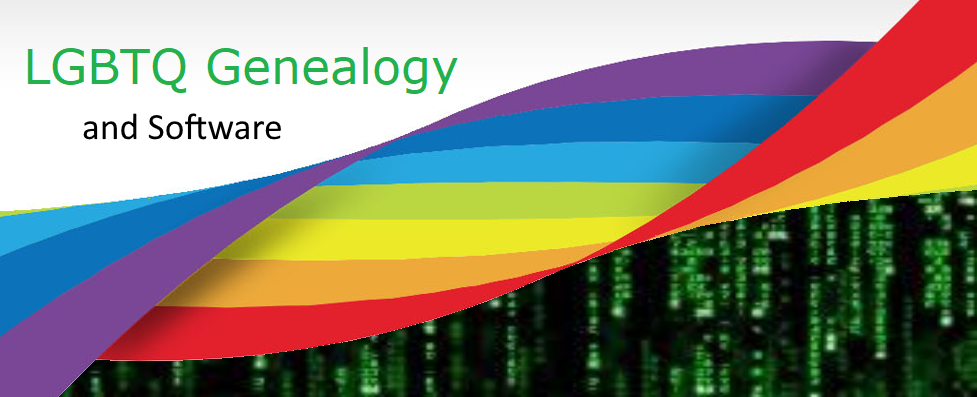GEDCOM
Last month, we delved into the possibility of having more LGBTQ-friendly genealogy software. A software that goes beyond DNA connections and embraces the concept of Family History. A system that acknowledges families with more than two opposite-sex parents, recognizing and weighing the importance of all parents beyond just biological (DNA) connections. We aim for software that comprehends the existence of more than two genders, including Trans, Non-Binary, Intersex, and others. A system that understands the intricate web of human relationships and identities beyond the conventional hetero-normative nuclear family unit.
When approaching software companies with requests for such modifications, the common response has been that they would love to make changes to include LGBTQ users, but that it’s not feasible due to limitations with GEDCOM, the Genealogical Data Communications standard. Developed by The Church of Jesus Christ of Latter-day Saints in 1984, GEDCOM has seen little development in over two decades.
Tamura Jones, a computer scientist, genealogy technologist, and GEDCOM expert, provides an insightful history and explanation of GEDCOM on his blog, Modern Software Experience. The current version, 5.5.1, is over 22 years old, which is ancient in the world of software. The blog post “A Gentle Introduction to GEDCOM” on 24 August 2010 provided the following GEDCOM history chart. [1]
This table shows the GEDCOM version history:
| date | version | brief note |
| 1984 | 1.0 | first version |
| 1985-12 | 2.0 | PAF 2.0 |
| 1987-02 | 2.1 | PAF 2.1 |
| 1987-10-09 | 3.0 | lineage-linked form |
| 1989-08-04 | 4.0 | |
| 1991-09-25 | 5.0 draft | lineage-linked structures |
| 1993-11-04 | 5.3 | Unicode, schema (abandoned), used draft |
| 1995-12-11 | 5.5 | official standard |
| 1999-10-02 | 5.5.1 | de facto standard |
| 2000-12-18 | 5.6 | unreleased draft |
| 2001-12-28 | 6.0 | abandoned draft |
An attempt to address this stagnation began in 2012 by the Family History Information Standards Organisation (FHISO), which grew out of the BetterGEDCOM wiki. FHISO is an international organization striving to improve information standards for genealogy and family history.
While FHISO worked on a new version, Tamura Jones took a step forward by introducing GEDCOM 5.5.5 in 2019. This version was the first to recognize same-sex partnerships and encoded data transmission of those unions. In version 5.5.5, same-sex unions became part of the standard code and are explicitly supported. GEDCOM 5.5.5 was also the first to include a SEX option other than M or F, allowing for X which supports Intersex, Trans, and Non-Binary. Genealogists should appeal to software developers to adopt the 5.5.5 standard. Continued development, news, and download of GEDCOM 5.5.5 can be found at GEDCOM.org.
In 2021, The Family History Department of The Church of Jesus Christ of Latter-day Saints introduced GEDCOM 7.0. Continuing news on this alternate GEDCOM can be found at FamilySearch GEDCOM. The second revision, version 7.0.2, was published on 15 June 2021. Luther Tychonievich, current Chair of FHISO, and Tony Proctor, former FHISO board member, contributed to version 7.0.[5]
The GEDCOM 7.0 specifications for a Family Record are explained as
“The FAM record was originally structured to represent families where a male HUSB (husband or father) and female WIFE (wife or mother) produce CHIL (children). The FAM record may also be used for cultural parallels to this, including nuclear families, marriage, cohabitation, fostering, adoption, and so on, regardless of the gender of the partners. Sex, gender, titles, and roles of partners should not be inferred based on the partner that the HUSB or WIFE structure points to.”[6]
Therefore, the Latter-day Saints version now allows for same-sex couples, which 5.5.5 already did. The antiquated HUSB and WIFE labels are still used for partners, but sex and gender should not be inferred from those labels. I’m assuming that continued use of these labels is a software limitation that has yet to be overcome. This is still a binary system without recognizing more than two parents in a family record.
The “Family Events” specifications do not recognize Domestic Partnerships or Civil Unions. They only recognize MARR = “A legal, common-law, or customary event such as a wedding or marriage ceremony that joins 2 partners to create or extend a family unit.”[7] GEDCOM 5.5.5 has a long list of supported relationships such as “partnership” and “registered partnership”. [4]
The GEDCOM 7.0 specifications for Sex are explained as,
“This can describe an individual’s reproductive or sexual anatomy at birth. Related concepts of gender identity or sexual preference are not currently given their own tag. Cultural or personal gender preference may be indicated using the FACT tag.”[8]
| Value | Meaning |
| M | Male |
| F | Female |
| X | Does not fit the typical definition of only Male or only Female |
| U | Cannot be determined from available sources |
In this spec language, there is at least a recognition that more than two genders exist (use value “x”). GEDCOM 5.5.5 used this same X, and therefore the Latter-day Saints version adds nothing new here. The specs identify the sex tag as being “sexual anatomy at birth” which implies a recognition of Transgender people but there is no promise of gender identity ever having a unique tag. Given the stagnant development by the Church over 20 years, I doubt the evolution of this category will ever happen. Sexual preference should not be categorized under the sex tag.
Since 1984 The Church of Jesus Christ of Latter-day Saints has shut out LGBTQ people from genealogical software by controlling the underlying data transfer protocol known as GEDCOM. Their new “update” finally recognizes same-sex unions and gender beyond M or F. But this is nothing new compared to the GEDCOM 5.5.5 standard published in 2019.
GEDCOM 5.5.5 offers a universal solution that can be adopted by all genealogical software vendors. GEDCOM 7.0 is a proprietary specification under religious control of The Church of Jesus Christ of Latter-day Saints, which has a proven track record of hostility to LGBTQ people. Louis Kessler writes in his blog post “Can GEDCOM 7.0 Succeed?” that FamilySearch trees do not support any GEDCOM version and doubts version 7.0 will be successful.[9]
For those interested in promoting the inclusivity of LGBTQ family history, advocating for the adoption of GEDCOM 5.5.5 by software companies is crucial. Some vendors are already supporting GEDCOM 5.5.5. It’s anticipated that this standard will continue evolving towards greater inclusivity of all relationships and genders.
[1] Tamura Jones, “A Gentle Introduction to GEDCOM,” Modern Software Experience, 24 August 2010 (https://www.tamurajones.net/AGentleIntroductionToGEDCOM.xhtml : accessed 1 May 2018), GEDCOM Version history chart.
[2] Family History Information Standards Organisation Inc., History of FHISO (https://fhiso.org/history/ : accessed 1 June 2021) .
[3] Family History Information Standards Organisation Inc., History of FHISO (https://fhiso.org/ : accessed 1 June 2021).
[4] Tamura Jones, “GEDCOM 5.5.5: Just a Revision,” Modern Software Experience, 2 October 2019 (https://www.tamurajones.net/GEDCOM555JustARevision.xhtml : accessed 3 October 2019). And, Tamura Jones, ” GEDCOM Relationships,” Modern Software Experience, 7 October 2019 (https://www.tamurajones.net/GEDCOMRelationships.xhtml : accessed 8 October 2019).
[5] Family History Department, The Church of Jesus Christ of Latter-day Saints, “The FamilySearch GEDCOM Specification: 7.0.2,” technical specifications, 15 June 2021, FamilySearch GEDCOM (https://gedcom.io/specifications/FamilySearchGEDCOMv7.html : accessed 15 June 2021), Section 5. Contributors.
[6] Family History Department, The Church of Jesus Christ of Latter-day Saints, “The FamilySearch GEDCOM Specification: 7.0.2,” technical specifications, 15 June 2021, FamilySearch GEDCOM (https://gedcom.io/specifications/FamilySearchGEDCOMv7.html : accessed 15 June 2021), Section 3.2.2. Records, Family_Record.
[7] Family History Department, The Church of Jesus Christ of Latter-day Saints, “The FamilySearch GEDCOM Specification: 7.0.2,” technical specifications, 15 June 2021, FamilySearch GEDCOM (https://gedcom.io/specifications/FamilySearchGEDCOMv7.html : accessed 15 June 2021), Section 3.3.1.2 Family Events.
[8] Family History Department, The Church of Jesus Christ of Latter-day Saints, “The FamilySearch GEDCOM Specification: 7.0.2,” technical specifications, 15 June 2021, FamilySearch GEDCOM (https://gedcom.io/specifications/FamilySearchGEDCOMv7.html : accessed 15 June 2021), Section 3.4. Enumeration Values, Sex.
[9] Louis Kessler, “Can GEDCOM 7.0 Succeed?,” Behold Genealogy, 16 June 2021 (https://www.beholdgenealogy.com/blog/?p=3826 : accessed 16 June 2021).



